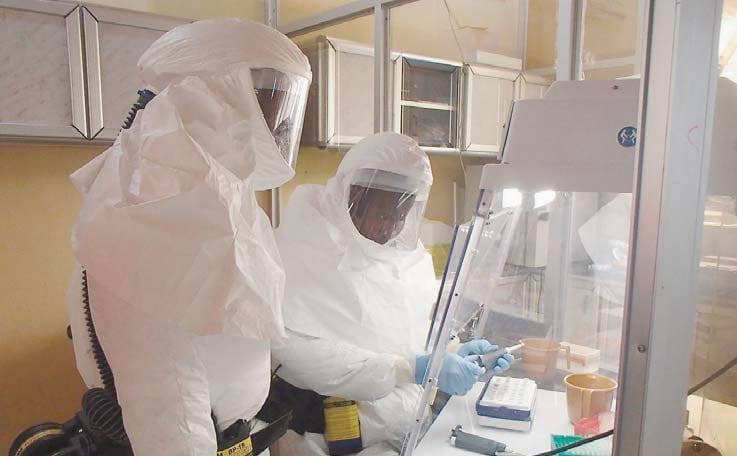The World Health Organization (WHO) has called for increased laboratory diagnostic capabilities for use in the Ebola crisis.
The goal of interrupting chains of Ebola virus transmission depends heavily on laboratory support, needed to confirm or discard suspected cases, guide triage and clinical decisions, aid contact tracing, and facilitate the early detection of cases in people with an exposure history.
The WHO goal of aggressive case detection and isolation likewise depends on laboratory support, stated the agency in an update released Nov. 18.
The standard molecular assays currently used in mobile and other laboratories supporting the Ebola response include the reverse-transcriptase polymerase chain reaction, or RT-PCR test.
The test, which involves a number of laborious procedures, provides very accurate results when performed by trained staff. Each test requires a full tube of blood, takes from 2 to 6 hours, and costs around $100. These requirements are difficult to meet in resource-constrained West African settings, thus severely limiting testing capacity.
Lost Time – For Patients and Treatments
The time lost transporting patient samples over bad roads to West Africa’s limited number of laboratories means that anxious patients and their families may need to wait several days for test results.
Lost time means that infected people may remain in the community, with a severe risk of unknowingly transmitting the virus to others. Moreover, in the absence of rapid laboratory support, people with other common infectious diseases, such as malaria and dengue, that have similar early symptoms may be unjustifiably held in an Ebola “transit” center as a precautionary measure. If they did not have Ebola when entering the center, they may unfortunately get it there.
Apart from posing a severe risk to families and communities, undiagnosed and unmanaged patients contribute to the cyclical transmission pattern currently being seen, whereby cases begin to fall as control measures take effect, only to spike again as new chains of transmission are ignited.
Perhaps most importantly, a recent research study, based on the management of more than 700 Ebola patients in Monrovia, Liberia, strongly suggests that clinical decisions guided by results from rapid point-of-care diagnostic tests could significantly improve treatment outcomes.
Moreover, having such tests readily available could restore some order to West African health systems, which have been devastated by fear of contagion as well as by the demands of managing a deadly and dreaded disease.
Apart from expediting the immediate outbreak response, rapid diagnostic tests will have enduring value in countries where many other endemic diseases mimic the early symptoms of Ebola. Having such tests in hand will also leave health services better prepared for a possible recurrence of Ebola in West Africa and elsewhere.
Initiatives to Stimulate Diagnostic Innovation
For all these reasons, WHO has launched two urgent initiatives to stimulate diagnostic innovation and expedite the delivery of better and faster tests to West African countries – compressed into months instead of years.
The first initiative aims to minimize the barriers faced by diagnostic companies to develop and deploy their tests by clearly defining the needs, by identifying channels to access early validation materials and clinical samples for research and development, and by preparing the deployment of these new tests in the affected countries. It is moving forward in close collaboration with manufacturers, academic researchers, staff from Médecins sans Frontières (MSF), and the non-profit organization Foundation for Innovative New Diagnostics, or FIND.
The Ideal Assay
To clearly define the needs and thus guide the development of tests, WHO issued a detailed profile of the “ideal” rapid, sensitive, safe and simple diagnostic test considered most likely to accelerate interruption of virus transmission in severely resource-constrained settings.
For example, the ideal test should be suited for use in peripheral health clinics with no laboratory infrastructure in place. Testing procedures should involve fewer than 3 steps, produce results in less than 30 minutes, and have no biosafety requirements beyond the wearing of personal protective equipment.
Additional operational specifications pertain to the easy storage and reconstitution of reagents and staff training that takes less than half a day. The ideal test and related portable equipment should need no power supply and require no maintenance.
In the absence of regulatory oversight of most commercial Ebola tests, WHO is also assessing the quality of these tests. To date, no rapid tests, either on the market or under development, have undergone full regulatory assessment, underscoring the need for an independent review of these products before they are used in the field. Some tests are marketed for research use only, and not for use with patients.
New Mechanism for Emergency Quality Assessment
The second WHO initiative comes with the establishment of an emergency quality assessment mechanism. This is a rapid review process for assessing a diagnostic’s quality, safety and performance.
In early October, an invitation was sent to manufacturers (.pdf), known to be working on diagnostic tests for Ebola virus, to submit documentation setting out the evidence they have compiled on the safety, quality and performance of the test. Information to be submitted includes the recommended specimen types; evidence of test performance, including sensitivity and specificity; suppliers of critical components or raw materials and services, and data on current inventory and manufacturing capacity and quality.
Sixteen sets of documentation were received by mid-October. These include conventional RT-PCR diagnostic kits, automated “desktop” PCR systems with integrated specimen processing, and new point-of-care tests that could – within minutes – detect Ebola virus infection with blood from a finger-prick instead of a full tube. The documentation is independently assessed for WHO by expert virologists; the performance of the most promising tests will be verified through a rapid laboratory evaluation using clinical specimens.
The emergency quality assessment mechanism is currently assessing the first 5 of the 16 documentation sets submitted to date. Australian, Belgian and Dutch reviewers are participating in the evaluation, together with staff from the WHO Prequalification of In Vitro Diagnostics Programme.
The overarching objective is to guide bulk procurement decisions by WHO and other partners that will get the best tests to West Africa within the next few months.
Source: WHO announcement, with adaptations.


